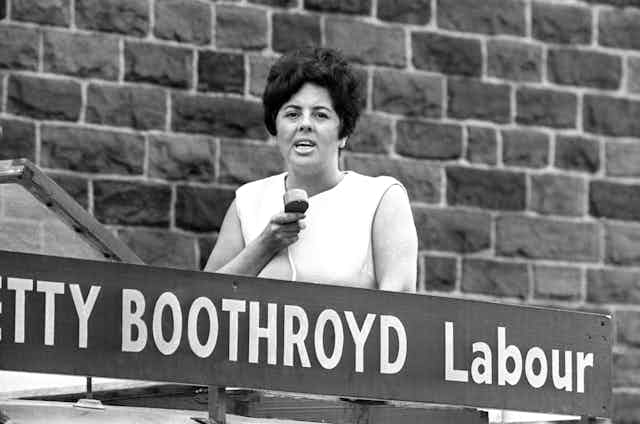Baroness Betty Boothroyd, who has died at the age of 93, was, in no uncertain terms, a parliamentary giant. With a career in Westminster spanning almost 50 years, she was best known for becoming the first (and so far only) female speaker of the House of Commons – a post she held from 1992 to 2000. It had taken over 700 years to see a woman in the speaker’s chair
Boothroyd served as member of parliament for West Bromwich between 1973 and 2000 and, after stepping down as speaker, was elevated to the House of Lords as a crossbench (independent) peer. She remained an active member of the second chamber until very late in her life.
Boothroyd was born in 1929 to mill workers in Drewsbury, West Yorkshire. She started her career as a dancer, joining the Tiller Girl dance troupe. Her natural theatrical flare and love of the limelight put her in great stead not only to be a fierce MP but to be able to tame the beast that is the House of Commons chamber as speaker.
On her road to Westminster, she worked for the famous firebrand MP Barbara Castle and spent a brief period working in the US on John F. Kennedy’s presidential campaign.
It took five attempts to get elected as an MP. She faced much misogyny for, among other things, being an unmarried woman in a man’s world. She was one of only 27 female MPs in the House of Commons at the time.

Serving in government, as a lot of MPs aspire to, was never a serious goal for Boothroyd. She served as an assistant whip in Harold Wilson’s 1974 administration but never sought further advancement. In 1987 she was elected to the position of deputy speaker and in this role she proved that she had authority and conviction, which set her up to launch her bid to be speaker of the House of Commons in 1992.
Defender of parliament
Boothroyd is best remembered for her no-nonsense approach to dealing with raucous MPs. This was a time when parliament was very male, pale and stale. She didn’t just break the glass ceiling – she smashed right through it.
Because her tenure as speaker coincided with the televising of House of Commons proceedings, Boothroyd became a household name in 1990s. The TV cameras picked up her now famous scolding of MPs – done with humour, wit and kindness – and made her one of the most well-known House of Commons speakers in history.
Upon her retirement in 2000, Blair noted that she had become “a cult figure in the United States” as a result of her personality during these televised interventions.
Boothroyd was willing to stand up to rowdy MPs and also governments with large majorities. In 1997, Blair won a 179-seat governing majority in the House of Commons (the largest in post-war history), which made it easier for the government to marginalise parliament as it could push legislation through without much resistance.
Boothroyd remained a champion of the House of Commons during this time, and was not afraid to tick off ministers who she felt had overstepped the mark.
She also deplored the growing tendency of Blair’s ministers to brief the press about government policy rather than first making statements in the House of Commons where they could be held to account. As such, she was a true defender of parliament’s central position within the British constitution.
She was, and remains, an example on which future speakers should model their conduct. The job, after all, is to be a defender of parliament (and the primacy of the House of Commons) and a fair mediator in debates.
Fairness in this regard is to ensure that regardless of the size of governing majorities, that all MPs, from all parties, (including backbench MPs in the governing party) get a good showing in debates. As speaker, Boothroyd’s job was not to make the government’s life easier but rather to be a champion of backbench MPs and their right to have their voices heard, regardless of party.
Boothroyd was at heart a traditionalist, and someone whose respect for the supremacy and sovereignty of parliament meant she was dearly respected by both sides of the House of Commons.
One of her other lasting legacies, beyond the precedence set for future speakers of the House of Commons, is her work alongside Dame Vera Lynn and Princess Anne in the creation of the Monument to the Women of World War II. This recognised the important but often overlooked role women played in the war effort.
Boothroyd’s life is a story of a woman born to mill workers who would go on to be elected to one of the highest offices in the land, as speaker of the House of Commons. She was a true parliamentarian and a dedicated public servant. In her own words (when asked how she would like to be remembered) she was “an honest and fair speaker”.

